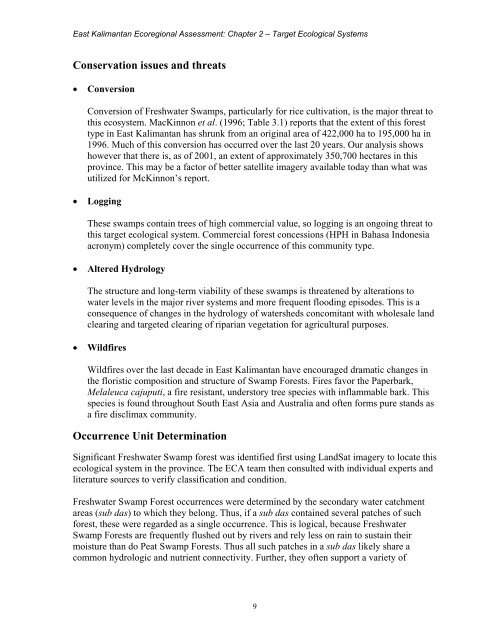Ecoregional Assessment of Biological Diversity in East Kalimantan
Ecoregional Assessment of Biological Diversity in East Kalimantan
Ecoregional Assessment of Biological Diversity in East Kalimantan
Create successful ePaper yourself
Turn your PDF publications into a flip-book with our unique Google optimized e-Paper software.
<strong>East</strong> <strong>Kalimantan</strong> <strong>Ecoregional</strong> <strong>Assessment</strong>: Chapter 2 – Target Ecological Systems<br />
Conservation issues and threats<br />
• Conversion<br />
Conversion <strong>of</strong> Freshwater Swamps, particularly for rice cultivation, is the major threat to<br />
this ecosystem. MacK<strong>in</strong>non et al. (1996; Table 3.1) reports that the extent <strong>of</strong> this forest<br />
type <strong>in</strong> <strong>East</strong> <strong>Kalimantan</strong> has shrunk from an orig<strong>in</strong>al area <strong>of</strong> 422,000 ha to 195,000 ha <strong>in</strong><br />
1996. Much <strong>of</strong> this conversion has occurred over the last 20 years. Our analysis shows<br />
however that there is, as <strong>of</strong> 2001, an extent <strong>of</strong> approximately 350,700 hectares <strong>in</strong> this<br />
prov<strong>in</strong>ce. This may be a factor <strong>of</strong> better satellite imagery available today than what was<br />
utilized for McK<strong>in</strong>non’s report.<br />
• Logg<strong>in</strong>g<br />
These swamps conta<strong>in</strong> trees <strong>of</strong> high commercial value, so logg<strong>in</strong>g is an ongo<strong>in</strong>g threat to<br />
this target ecological system. Commercial forest concessions (HPH <strong>in</strong> Bahasa Indonesia<br />
acronym) completely cover the s<strong>in</strong>gle occurrence <strong>of</strong> this community type.<br />
• Altered Hydrology<br />
The structure and long-term viability <strong>of</strong> these swamps is threatened by alterations to<br />
water levels <strong>in</strong> the major river systems and more frequent flood<strong>in</strong>g episodes. This is a<br />
consequence <strong>of</strong> changes <strong>in</strong> the hydrology <strong>of</strong> watersheds concomitant with wholesale land<br />
clear<strong>in</strong>g and targeted clear<strong>in</strong>g <strong>of</strong> riparian vegetation for agricultural purposes.<br />
• Wildfires<br />
Wildfires over the last decade <strong>in</strong> <strong>East</strong> <strong>Kalimantan</strong> have encouraged dramatic changes <strong>in</strong><br />
the floristic composition and structure <strong>of</strong> Swamp Forests. Fires favor the Paperbark,<br />
Melaleuca cajuputi, a fire resistant, understory tree species with <strong>in</strong>flammable bark. This<br />
species is found throughout South <strong>East</strong> Asia and Australia and <strong>of</strong>ten forms pure stands as<br />
a fire disclimax community.<br />
Occurrence Unit Determ<strong>in</strong>ation<br />
Significant Freshwater Swamp forest was identified first us<strong>in</strong>g LandSat imagery to locate this<br />
ecological system <strong>in</strong> the prov<strong>in</strong>ce. The ECA team then consulted with <strong>in</strong>dividual experts and<br />
literature sources to verify classification and condition.<br />
Freshwater Swamp Forest occurrences were determ<strong>in</strong>ed by the secondary water catchment<br />
areas (sub das) to which they belong. Thus, if a sub das conta<strong>in</strong>ed several patches <strong>of</strong> such<br />
forest, these were regarded as a s<strong>in</strong>gle occurrence. This is logical, because Freshwater<br />
Swamp Forests are frequently flushed out by rivers and rely less on ra<strong>in</strong> to susta<strong>in</strong> their<br />
moisture than do Peat Swamp Forests. Thus all such patches <strong>in</strong> a sub das likely share a<br />
common hydrologic and nutrient connectivity. Further, they <strong>of</strong>ten support a variety <strong>of</strong><br />
9

















